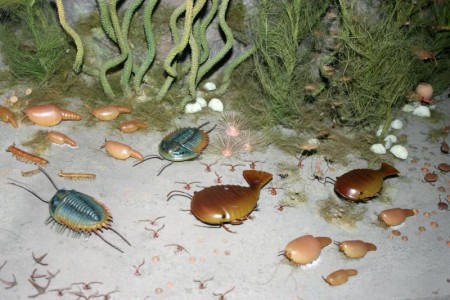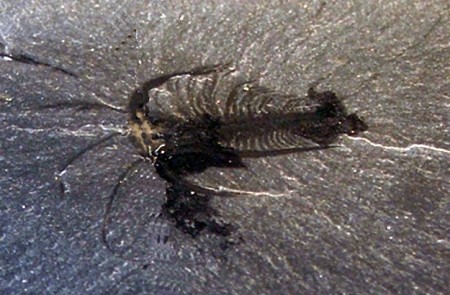February 27, 2016 – The first time I saw pictures of fossils from the Burgess Shales of Western Canada (see image below) I became intrigued about how complex life emerged here on Earth some 540 million years ago. Before then there was life but it was largely single cell and had existed for three billion years. But something happened on Earth that triggered a rapid evolution in life forms and scientists have been trying to figure out the cause for more than a century.
In the Precambrian world life was simple. In the Cambrian world life became complex. It happened in a blink of an eye in geological time, a few million years. From single celled creatures arose worms, arthropods, and animals with precursors to backbones.
What makes this so very interesting? A sudden change in the geological record points to some singular revolutionary or evolutionary event. Was this an environmental trigger? How or what made our planet cross an ecological boundary and suddenly produce complex animals, predators, carnivores, exoskeletons, teeth, and shells?
Paleontologists have theorized that oxygen played a significant role in the rise of life complexity. They have been searching for evidence to support the theory. Analyzing ancient seabeds for metals that only exist in the presence of oxygen would be the smoking gun. Past studies show samples from seabeds that would indicate a rise in oxygen in stages until 541 million years ago. But more recent studies dispute the evidence arguing that if oxygenation did occur it was not that significant to explain the Cambrian explosion. In fact, studies show evidence of free oxygen in the atmosphere and ocean at higher levels predating the Cambrian.
What kind of amounts are we talking about? In our atmosphere today oxygen represents 21% of the air we breathe. In areas of the ocean today where we have low oxygen we still find life. At 0.5% concentration in seawater that life is largely microbial. At 3% we find a limited number of complex life forms. But somewhere between 3 and 10% we see lots of life and a complex food chain that includes large predators at the top.
Evidence in the Burgess Shale fossils shows a number of large predators. Their existence supports the hypothesis that oxygen levels must have significantly increased at the beginning of the Cambrian.
But could it have been a genetic trigger that led to the first arthropod Adam and Eve? Could all of this have started from the mutation of a single gene, or better yet a protein? Ken Prehoda, a biochemist at University of Oregon, believes complex life arose because of a mutation that happened to a single protein. Prehoda states that proteins are the “workhorses of our cells, performing a wide variety of tasks such as metabolism.”
And all that is required to change life is one small mutation altering the function of a protein. Prehoda believes there is evidence of this mutated protein in all living animals today, a protein that originates from our single-celled ancestors and that can still be found in a creature today, the choanoflagellate.
Choanoflagellates can exist on their unicellular own or in multicellular colonies. They have a flagellum (a tail-like appendage) which they wiggle to help them navigate and gather food. A protein receiving genetic instructions within the choanoflagellate is responsible for the tail’s formation. We can find the protein’s descendants in all living animals today but it no longer functions as it did in our unicellular ancestors or as it does in choanoflagellates in the present day. It now performs a completely different task triggering multicellular division.
The protein has mutated and it has been so successful that Prehoda states “70 of them” can be found “inside of us” today. How did this come about? Prehoda believes the mutation was triggered when the gene that instructs it duplicated within a cell. Instead of building a flagellum the protein changed tasks and started to instruct its unicellular host to build new cells and arrange them in new ways leading to life like us.
Did an oxygenation event have anything to do with the protein’s mutation? Probably not. But the life forms that came from that protein’s changed function may have ultimately contributed to subsequent increases in oxygen to a level not previously seen on Earth.
If complex and intelligent life could evolve here through a random mutation, imagine how many different outcomes could come from life elsewhere. And imagine how different that life might be from what produced us.











